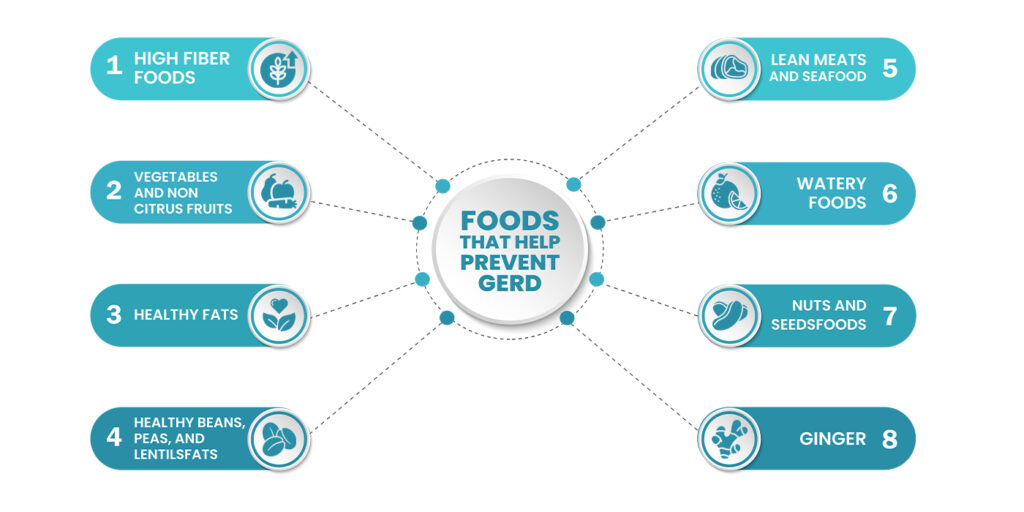If you have ever felt that burning sensation creeping up from your stomach to your chest after a meal, you are not alone. Acid reflux and GERD (Gastroesophageal reflux disease) are very common digestive health issues. They can turn something as simple as eating into a source of stress. While lifestyle changes and medications help, what you eat plays a big role in managing acid reflux or GERD symptoms.
The good news? There are many delicious and gut-friendly foods that can help keep the discomfort at bay.
In this blog, we are going to explore the best foods to help with acid reflux or GERD that you can incorporate into your diet, along with some healthy eating habits to manage symptoms.
Foods That Help With Acid Reflux:

1. High Fiber Foods:
Fiber is a key player when it comes to digestive health. It helps keep things smoothly moving in your digestive tract. High fiber foods add bulk to your meal without increasing acidity. They also help to make you feel full and prevent overeating, which is a major trigger for acid reflux.
Here are some high-fiber foods that you can add in your diet:
- Oatmeal
- Whole grain bread
- Couscous
- Brown rice
- Quinoa
- Sweet potatoes
- Carrots
- Beats
Starting your day with a fiber rich breakfast can decrease your chances of having acid reflux later on.
2. Vegetables and Non-Citrus Fruits:
Vegetables are naturally low in fat and sugar, which are the two main culprits behind acid reflux flare-ups.
Non-citrus fruits make a reflux-friendly snack, especially when compared to other high in fat and sugar snacks such as chocolate.
Best vegetables for acid reflux include:
- Broccoli
- Asparagus
- Cucumber
- Green beans
- Peas
- Brussels sprouts
- Spinach
Non-citrus fruits to try:
- Bananas
- Apples
- Pears
- Melons
These vegetables and fruits are not only gentle on the stomach but are also rich in vitamins and antioxidants that support overall digestive health.
3. Healthy Fats:
Not all fats are equal. While greasy, fried foods can worsen acid reflux, healthy, unsaturated fats can actually have a soothing effect on your digestive system.
Some healthy fat sources are:
- Avocado
- Flaxseeds
- Walnuts
- Soy products
- Olive oil
- Sesame oil
- Sunflower oil
- Fatty fish such as salmon and trout
4. Beans, Peas, and Lentils:
Legumes are high in fiber and protein but are low in fat which makes them ideal to prevent acid reflux. They are also great alternatives to high fat meats that can worsen the symptoms of GERD and acid reflux.
Examples:
- Lentils
- Black beans
- Chickpeas
- Kidney beans
- Split peas
Try incorporating a lentil soup or chickpea salad into your meal plan. They are hearty, satisfying, and gentle on your stomach.
5. Lean Meats and Seafood:
Fatty meats like bacon and sausage can trigger acid reflux, but lean sources of protein are generally safe.
Stick to grilled, steamed, or baked options to avoid added fat and grease.
Good choices of lean meat and seafood are:
- Skinless chicken breast
- Turkey
- White fish like cod or tilapia
- Shellfish (shrimps, scallops)
- Eggs (especially egg whites)
Lean meats are low in fat and easier to digest without aggravating your symptoms.
6. Watery foods:
Foods with high water content can help dilute stomach acid. They also keep you hydrated which supports overall digestion.
Here are some hydrating foods you can add in your diet:
- Lettuce
- Celery
- Cucumber
- Water-melon
- Broth based soups
- Herbal teas
These options are refreshing especially in the warmer months, and make great snacks or side dishes for a reflux-friendly meal.
7. Nuts and Seeds:
In moderation, certain nuts and seeds can be a good source of healthy fats and fiber, both of which are helpful in managing GERD. They may also help absorb stomach acid. However, steer clear of overly salted or roasted varieties which may contain added oils and irritants.
Best options include:
- Almonds
- Chia seeds
- Flaxseeds
- Peanuts
- Walnuts (in small amounts)
You can sprinkle some flaxseeds on your oatmeal or blend chia seeds into your smoothie for a digestion friendly nutrient boost.
8. Ginger:
Ginger has been used for centuries as a natural remedy for different digestive issues, including nausea and indigestion. Not only is ginger soothing but it also gives a flavourful boost to your meals.
It may help with acid reflux as it supports gastric emptying, which means it helps move food forward from your stomach more efficiently.
However, ginger may not be beneficial for everyone. In some people, it may trigger acid reflux. So it is best to start with small quantities to see how your body reacts.
Here are a few ways in which you can add ginger in your diet:
- Ginger tea
- Freshly grated or sliced ginger in your meals
- Smoothies with a touch of ginger
- Ginger infused water
It should be noted that these foods don’t cure GERD or acid reflux, they can help manage symptoms. Everyone reacts differently, so it is important to pay attention to how specific foods affect you.
Healthy Eating Habits for Managing GERD:
Here are some smart and healthy eating habits that can help manage acid reflux and symptoms of GERD:
- Eat smaller and frequent meals, as large meals can put pressure on your stomach and increase the risk of acid reflux.
- Don’t lie down right after eating. Try to wait for at least 2 to 3 hours.
- Chew your food thoroughly and eat slowly to avoid overeating.
- Stay upright during and after meals. It helps gravity keep stomach acid where it belongs.
- Avoid foods that can trigger GERD or acid reflux.
- Avoid eating late at night.
- Maintain a healthy body weight.
Final Thoughts:
Managing acid reflux or GERD doesn’t mean you have to give up flavour and variety in your diet. With the right food choices, you can ease symptoms, support digestion, and prevent flare-ups altogether. Focus on whole, unprocessed foods, eat smaller meals, and avoid eating too close to bedtime. Your gut will thank you!








